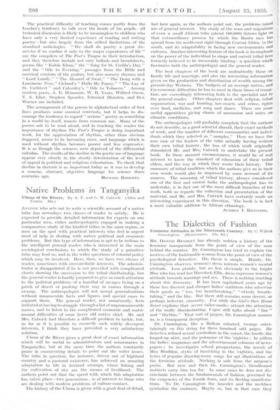The Dialectics of Fashion
Feminine Attitudes In the Nineteenth Century. By C. Willett Cunnington. (Heinemann. 12s. 6d. )
AIR. DENNIS BRADLEY has already written a history of the feminine masquerade from the point of view of the man behind the counter. Dr. Cunnington has tried to explain the motives of the fashionable woman from the point of view of the psychological detective. His thesis is simple. Mainly, Dr. Cunnington observes, women's dress mirrors women's mental attitude. Less plainly, but no less obviously to the bright Miss who has read her Havelock Ellis, dress expresses women's attitude towards marriage and sex. There is nothing startling about this discovery. It has been capitalised years ago by those less discreet and cheaper ladies' outfitters who advertise their goods as " too, too heartbreaking," " utterly breath- taking," and the like. 13ut there still remains some decent, or perhaps indecent, obscurity. For while the Girl's Own Home Sewer explains that severe tailor-mades attract the attention of the really discriminating, Vogue still talks about " line " and "rhythm." That sort of jargon, Dr. Cunnington assures us, is a transparent deception.
Dr. Cunnington, like a Balkan minstrel, twangs enter- tainingly on this string for three hundred odd pages. He detects a refined sexual symbolism in the corset, the bustle, the looped-up skirt, and the polonaise of the 'eighties : he pilfers the ladies' magazines and the advertisement columns of news- papers ; he investigates school prospectuses, the novels of Miss Braddon, styles of furnishing in the 'eighties, and the lyrics of popular drawing-room songs for apt illustrations of the feminine attitude. Nothing is safe from the surgeon's probe. But now and then Dr. Cunnington's bloodhound instincts carry him too far. In some cases he does not dis- criminate between the fundamentals of fashion, governed by the exigencies of the female form, and its fleeting manifesta- tions. To Dr. Cunnington the bracelet and the necklace symbolize the embrace. Maybe so, but in that case they represent not an attitude but an instinct. As long as arms and n eeks continue three-dimensional, they will have to suffer, it seems, the circumambience of jewellery and the irony of psychologists. There are, perhaps, one or two other postulates of Dr. Cunnington's that need clarification. In his opinion a fashion In Crude colours denotes a restless dissatisfaction of mind.. Was then the fin-de-sickle, with its craze for pastel pinks and hydrangea blues, an age more static and equable than the garish 'sixties ? Do the crude greens and reds of peasant costume imply a permanent irritation with the weather Again, Dr. Cunnington speaks of the national predilection for the " Gothic " style. He seems to use the word in a derogatory, 0!, at any rate, in a French sense. But the English modifica- tion of continental Gothic architecture was always tov,auds a greater simplicity. The Gothic revival of the eighteenth century vas confined to a narrow section of society. Fonthill Was never typical of contemporary English country-house architecture. Victorian Gothic was, in fact, the only strictly national manifestation of this spirit. Dr. Cunnington has Id himself be overshadowed by the Albert Memorial. His generalization is only true of the nineteenth century.
• The surface history of fashion is, after all, comparatively easy to write, but Dr. Cunnington attempts to explain causes es well as to describe effects. It is here that the book rather fails in its emphasis. Here and there Dr. Cunnington relates the feminine attitude to the economic background, and just here and there his argument is complete and convincing. Whenever this reference is absent or obscure, the argument
e▪ i feeble and skimpy, and all Dr. Cunnington's witty ornament Cannot disguise this historical jerry-building. Dr. Cunnington himself suggests lines of investigation, or rather, lines of correlation which, followed up, would have produced a sounder structure. " Fashion," he says, " was woman's chief or only means of self-expression," and the direction of this Self-expression was determined by the prevailing artistic and social winds. The influence of Pugin on dress, lightly hinted
could have been developed more fully in Dr. Cunnington's delightful chapter on " The Perfect Lady of the '50's," The Pre-Raphaelites are hardly mentioned, although their
in▪ fluence on fashion was profound.
This book stimulates criticism, perhaps unfair criticism, because it sets itself such a high standard. It is to be hoped drat lot Dr. Cunnington will one day apply his patience and his irony to a history of feminine attitudes of the twentieth century, with special chapters on the Perfect Hoyden of the 20'S, and the influence of male dress-designers on fashions.
SALLY GRAVES.



































 Previous page
Previous page